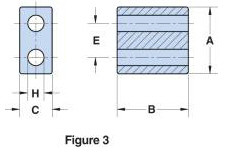Multi-Aperture cores (2861010002)
61 MULTI-APERTURE CORE
61 Material™
Suppression Components
Board Component
Printer Friendly Data Sheet
Check Stock

Part Number: 2861010002
61 MULTI-APERTURE CORE
Explanation of Part Numbers:
– Digits 1 & 2 = Product Class
– Digits 3 & 4 = Material Grade
– Last digit 2 = Burnished
Multi-aperture cores are used in suppression applications and in balun (balance-unbalance) and other broadband transformers. They are also employed in airbag designs to prevent accidental activation.
All multi-aperture cores are supplied burnished.
Our “Multi-Aperture Core Kit” (part number 0199000036) is available for prototype evaluation.
For any multi-aperture requirement not listed here, feel free to contact our customer service group for availability and pricing.
Weight: 46 (g)
| Dim | mm | mm tol | nominal inch | inch misc. |
| A | 30.2 | ±0.60 | 1.189 | _ |
| B | 28.7 | ±0.70 | 1.13 | _ |
| C | 15 | ±0.40 | 0.591 | _ |
| E | 14.6 | ±0.40 | 0.575 | _ |
| H | 6.8 | ±0.2 | 0.268 | _ |

Chart Legend
+ Test frequency
| Typical Impedance (Ω) | |
| 100 MHz | 557 |
| 250 MHz | 748 |
| Electrical Properties | |
| AL(nH) | 800 Min |
Multi-aperture cores in 73 and 43 materials are controlled for impedance only. The 61 NiZn material is controlled for both impedance and AL value. The high frequency 67 material is controlled for AL value. Minimum impedance values are specified for the + marked frequencies. The minimum impedance is typically the listed impedance less 20%.
Multi-aperture cores in 73 and 43 material are measured for impedance on the E4990A Impedance Analyzer. The 61 and 67 multi-aperture cores are tested on the E4991A / HP4291B Impedance Analyzer. All impedance measurements are performed with a single turn to both holes, using the shortest practical wire length.
The 61 and 67 material multi-hole beads are tested for AL value. The test frequency is 10 kHz at < 10 gauss. The test winding is five turns wound through both holes.
A high frequency NiZn ferrite developed for a range of inductive applications up to 25 MHz. This material is also used in EMI applications for suppression of noise frequencies above 200 MHz. Excellent stability characteristics.
Strong magnetic fields or excessive mechanical stresses may result in irreversible changes in permeability and losses.
Available in 61 material™:
EMI Suppression Beads
Beads On Leads
SM beads
Wound Beads
Multi-Aperture Cores
Round Cable Snap-Its
Toroids
Rods
Antenna/RFID
Rods
Round EMI Suppression Cores
61 Material™ Characteristics
| Property | Unit | Symbol | Value |
| Initial Permeability @ B < 10 gauss | µi | 125 | |
| Flux Density @ Field Strength | Gauss Oersted |
B H |
2500 15 |
| Residual Flux Density | Gauss | Br | 1000 |
| Coercive Force | Oersted | Hc | 1.2 |
| Loss Factor @ Frequency | 10 -6 MHz |
Tan δ/ µi | 90 10 |
| Temperature Coefficient of Initial Permeability (20 -70°C) | %/°C | .10 | |
| Curie Temperature | °C | Tc | >300 |
| Resistivity | ohm-cm | ρ | 1×108 |
**** Characteristic curves are measured on standard Toroids (18/10/6 mm) at 25°C and 10 kHz unless otherwise indicated. Impedance characteristics are measured on standard shield beads (3.5/1.3/6.0 mm) unless otherwise indicated.
Material Safety Data Sheet (MSDS)
Click here to download Complex Permeability vs. Frequency (CSV)










Click here to download 61 Material Power Loss Density vs. Flux Density at 25°C
Ferrite Material Constants
Storage and Operating Temperature
Printer Friendly Data Sheet - Download as pdf file
